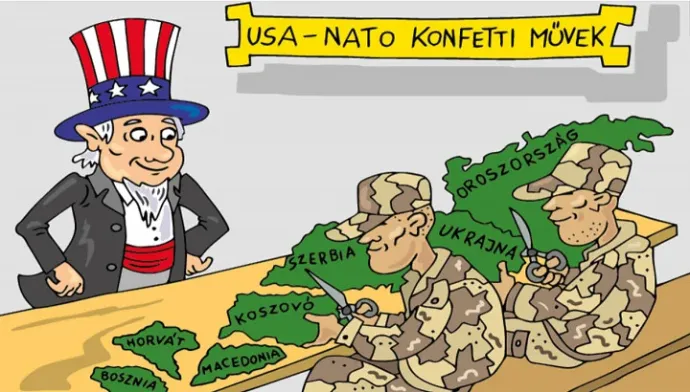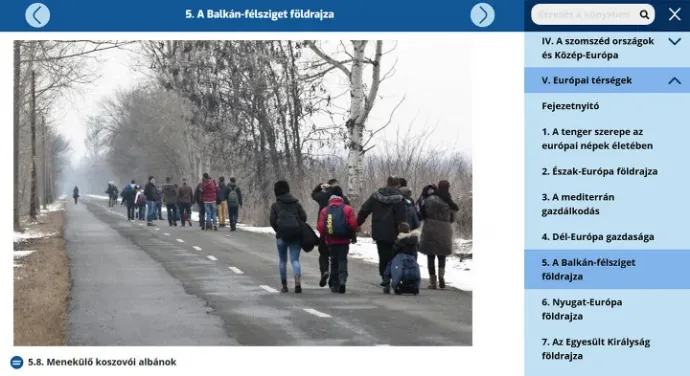Propaganda in the geography book, part 2: NATO and the USA are to blame for the Yugoslav wars
September 09. 2022. – 09:46 AM
updated
The part about Ukraine is not the only objectionable part of the eighth-grade geography "smart textbook" currently available on the Public Education Platform according to letters from our readers. Among others, several geography teachers, have pointed out that the part on the former Yugoslavia is also highly manipulative, it does not mention the real causes of the civil war in the former Yugoslavia and it deals with ethnic issues rather evasively. Next year's eighth-graders will have new geography textbooks to learn from, but the situation does not look much better for them either.
It is not only the internationally controversial section on Ukraine that is of concern in one of the two official, state-approved geography textbooks for use by 8th graders this year – we will return to the exact nature of the state textbook system later – but there are equally serious problems in the chapter on our country's southern neighbours as well. This was brought to our attention by geography teachers after we reported that in the 'smart textbook' available on the National Public Education Platform, the section on Ukraine does not even mention the events in eastern Ukraine in 2014 and the section on Crimea heavily glosses over things, saying: 'there is a significant Russian population in the east of the country, and Russians are the majority in Crimea (...) the two ethnic groups oppose each other often, which has also sparked armed conflict over Crimea."
Just look, don’t think
After our article was published, several readers pointed out that the part of the textbook dealing with the break-up of Yugoslavia and the civil wars of the 1990s that followed was similarly muddied and, to use a well-known phrase, doesn’t exactly unpack the whole truth. Or as one of our geography teacher readers put it: "the indoctrination is taking place about other topics as well".
The war in Yugoslavia, as we know, broke out in 1991 following the independence aspirations of the Yugoslav member states, and lasted for roughly ten years in three distinct phases. The two main triggers of the war were the intensification of the previously artificially suppressed antagonism between the different ethnic groups and the aggressive Serbian expansionist policy, the strengthening of Serbian hegemony within Yugoslavia (nationalism was on the rise among Croats, Bosniaks and Albanians, in addition to Serbia). The South Slavic war was the bloodiest armed conflict on the continent since the Second World War, with many civilian casualties due to ethnic cleansing, such as the Srebrenica massacre, which resulted in the deaths of more than 8,000 Bosniaks and was declared a war crime, and in Kosovo, the Albanian-Serb conflict remains unresolved to this day.
And what are the textbook writers passing on to 14-15 year olds about all this? First of all, they use the picture below – because a picture, as we all know, is worth a thousand words. One might say this is "just" a caricature, which the children have to interpret according to the task in the "smart book" (the task is literally "2.9. Explain the cartoon! Give it a title!"):

Honestly, how else can this caricature be interpreted other than that the break-up of Yugoslavia was caused by the US-led NATO military intervention? And what title can it be given other than something like "The imperialists are preparing a new war"? But since that was for sure already used in 1949, "Yugoslavia under the power of the Anglo-American imperialists" might work. No, wait....that was used in the nineteen fifties.
Does this caricature reveal anything about nationalist politicians, Milošević, Tudjman, or the plan to partition Bosnia and Herzegovina? Does it say anything about Kosovo, the bombing of Vukovar, the incident in Barcs (the accidental bombing of the small Hungarian town a few kilometres from the border with Croatia),or the Serb Republic of Krajina? The answer is too obvious to write down. And okay, maybe not everything listed here could have been written about in the textbook, but let's see what they managed to include:
- Croatia: "In 1991, following Slovenia, Croatia also wanted to leave the alliance, but Serbia tried to prevent this with military force. In the armed conflict between 1991-1995, known as the Yugoslav civil war, hundreds of thousands died or became refugees. During the war, the Serbs occupied northeastern Croatia, from where some 150,000 Serbs fled."
- Serbia: "Serbia has suffered more than Croatia from the break-up of Yugoslavia and the crisis this brought on the region. Recovery from it has not been as quick and successful for Serbia.
- Bosnia and Herzegovina: 'The bridge in Mostar, Bosnia and Herzegovina, has also fallen victim to the South Slavic war' (caption under a tourist stock photo with the bridge intact) "The mixing of nationalities has caused many problems in the region, for example it was a major factor in the outbreak of the civil war in the early 1990s."
- Ethnic issues: "The war made the population of both countries [Croatia and Serbia] more homogeneous, as mainly people belonging to minorities were forced to flee." (Nothing about ethnic cleansing, or the killing of civilians.)
- Slobodan Milošević: Nothing.
- Srebrenica: Nothing.
- Kosovo: "Fleeing Kosovar Albanians" (Caption under a photo without any context. A search on the photo reveals that it was a press photo taken during the 2015 refugee wave in Hungary, the original caption was "In early February hundreds of people arrived in Ásotthalom by the hour, this number has now dropped to a few dozen", although the text around it was really about Kosovar Albanian refugees).

We asked the Department of Education how such a chapter, or actually several chapters could have been developed. The former Yugoslav member states are discussed in different parts of the textbook: Slovenia (discussed with Austria), Serbia and Croatia are presented together, while the other former Yugoslav member states are elsewhere in the textbook. We also asked the Authority who the professional reviewer and approver of these sections was, as well as how the chapter on Ukraine mentioned earlier could have been prepared and become part of a textbook. Until the publication of our article, we have not received an answer to any of these questions.
Farewell to the two uglies
What is certain for now is that the current eighth-graders are the last to be taught from this eighth-grade geography textbook, produced by Eszterházy Károly College and the Institute for Educational Research and Development (now incorporated into the Department of Education) and licensed in 2018. In fact, there is another eighth grade geography textbook currently in circulation – although we could not find it on the Public Education Platform- which was previously published by publishing house Apáczai Kiadó. In it, for example, the 2014 events in eastern Ukraine are described even more correctly and in more detail – as we reported. On the other hand, this textbook is also tight-lipped about the post-1990 events in the former Yugoslavia, without mentioning the causes or the ethnic question in general, but at least it mentions Kosovo and does not blame NATO or the US for anything.
However, these textbooks will be phased out this year. Next year's eighth-graders have already received the merged 7th-8th grade geography textbook, which is based on the new National Core Curriculum and which they will be using next year too. There are (and will be) two textbooks in circulation, an A (link) and a B (link) version. However each version was developed by one of the authors of the current, scandalous textbook (László Szőllőssy and Adél F. Kusztor) while the author of the previous Apáczai book has completely disappeared from the list of authors of new textbooks.
And what will they be learning next year?
Neither of the new books contains the objectionable (to put it lightly) caricatures but the situation is not much better in the text section. In the case of Ukraine, in Version A, the population is described as follows: "The majority of its population is of Ukrainian nationality, but there is a significant proportion of Russians in the south and east of the country, and they constitute a majority in the Crimean Peninsula. The two Eastern Slavic languages are closely related, with many speaking a mixed Ukrainian-Russian language" so there is no mention of the events that happened in Crimea or in Eastern Ukraine.
Version B simply says: "The majority identify themselves as Ukrainian. The ethnic Russians make up about one fifth of the population and live mainly in the eastern part of the country. In Crimea, Russians make up the majority of the population', any reference to the 2014 conflict has been removed.
There is some improvement in the passages on the former Yugoslavia. For example, the cartoon blaming NATO has been removed and the text has been changed to read: 'When the Serbs sought to take the lead in Yugoslavia, this resulted in increasing tensions in the country where people groups from different cultural backgrounds were living in differently developed areas. In an attempt to prevent the break-up of the state when Slovenia and Croatia declared their independence in 1991, Serbia resorted to military force. The resulting armed conflict between 1991 and 1995, known as the Yugoslav civil war, left hundreds of thousands dead or displaced. As it was mainly people belonging to minorities who were forced to flee, their numbers dropped significantly in both Serbia and Croatia."
Bosnia and Herzegovina or the question of Kosovo are not even mentioned, and all it says of the former is that "there is no other area of Europe where there is such a mix of nationalities as in the Balkans. Bosnia and Herzegovina is the most complex in this respect, with Bosniaks, Croats and Serbs living on its territory."
Version B of the new textbook is unique in that it treats the former Yugoslavia within a single lesson. It deals with the civil war and the issue of independence in a longer, framed text. This is what it says: "The break-up of the former Yugoslavia was not smooth", and then goes on to say that "The war in Yugoslavia, which broke out over the independence of the member republics took place between 1991 and 1995. Many people died in the fighting and many were forced to flee their homes. As a result of population movement, the countries became more ethnically homogeneous. It took many years for these countries to recover from the damage caused by the war. Kosovo was the last to declare independence, but its independence is still disputed internationally."
For more quick, accurate and impartial news from and about Hungary, subscribe to the Telex English newsletter!
The translation of this article was made possible by our cooperation with the Heinrich Böll Foundation.